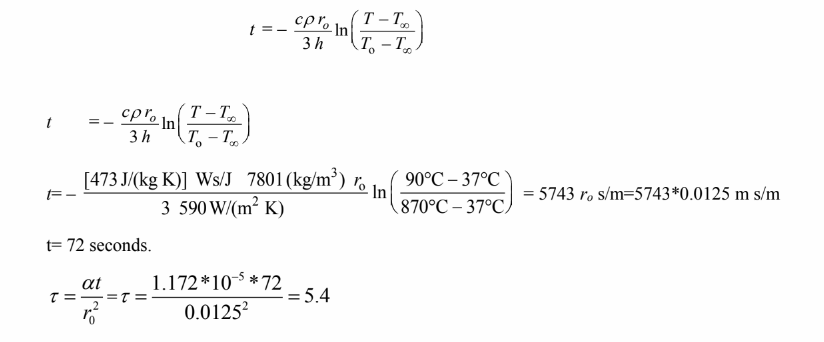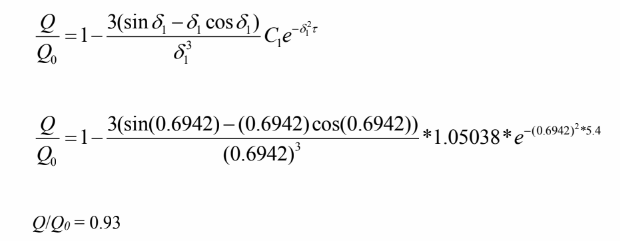Ball bearings are to be hardened by quenching them in a water bath at a temperature of 37°C. You are asked to devise a continuous process in which the balls roll from a soaking oven at a uniform temperature of 870°C into the water, where they are carried away by a rubber conveyer belt. The rubber conveyor belt, however, is not satisfactory if the surface temperature of the balls leaving the water is above 90°C. If the surface coefficient of heat transfer between the balls and the water may be assumed to be equal to 590 W/(m2 K), (a) find an approximate relation giving the minimum allowable cooling time in the water as a function of the ball radius for balls up to 1.0-cm in diameter, (b) calculate the cooling time, in seconds, required for a ball having a 2.5- cm-diameter, and (c)
calculate the total amount of heat in watts which has to be removed from the water bath in order to maintain a uniform temperature if 100,000 balls of 2.5-cm-diameter are to be quenched per hour.
GIVEN

FIND
(a) An approximate relation giving the minimum allowable cooling time in the water as a function of the ball
radius for balls upto 1.0 cm in diameter
(b) The cooling time, in seconds, required for a ball having a 2.5-cm-diameter
(c) The total amount of heat in watts which would have to be removed from the water bath in order to
maintain its temperature uniform if 100,000 balls of 2.5 cm diameter are to be quenched per hour
ASSUMPTIONS
The ball bearings are 1% carbon steel
SKETCH

(a) For 1.0-cm-diameter balls

Therefore, a lumped capacity method can be used for balls less than 1 cm in diameter. The time temperature
history of the ball is given by

Solving for the minimum cooling time

(b) For balls having a diameter of 2.5 cm

The internal resistance is not significant.
Therefore, a lumped capacity method can be used for balls less than 1 cm in diameter. The time temperature history of the ball is given by

Solving for the minimum cooling time

(c) We have for approximate solutions:

for sphere for Bi=0.17

From approximate solution for sphere


The amount of heat needed to quench 100,000 balls per hour is

You might also like to view...
The direction of the magnetic field of a bar magnet is
a. in the direction opposite to that in which a compass would point. b. in any direction. c. away from the south pole. d. away from the north pole.
A high tide is occurring at Charleston, South Carolina (70°W, 12°N). At approximately what other longitude is a high tide occurring?
a. 110°E b. 70°E c. 20°E d. 20°W e. 110°W
Why is it summer in the Northern Hemisphere when it is winter in the Southern Hemisphere?
A) The Northern Hemisphere is closer to the Sun than the Southern Hemisphere. B) The Northern Hemisphere is "on top" of Earth and therefore receives more sunlight. C) The Northern Hemisphere is tilted toward the Sun and receives more direct sunlight. D) The Northern Hemisphere is tilted away from the Sun and receives more indirect sunlight. E) It isn't: both hemispheres have the same seasons at the same time.
As the index of refraction gets larger:
a. light bends less for a given angle of incidence. b. the angle of incidence gets larger. c. light bends more for a given angle of incidence. d. the angle of incidence gets smaller. e. it has no effect on how the light bends.